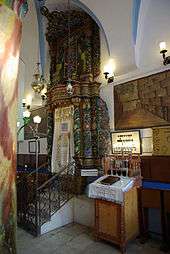Ari Ashkenazi Synagogue


The Ari Ashkenazi Synagogue, located in Safed, Israel, was built in memory of Rabbi Isaac Luria, (1534 - 1572), who was known as the "Ari".[1] It dates from the late 16th-century, it being constructed several years after the death of Luria, a great kabbalist who arrived in Safed in 1570. A Hebrew inscription above the entrance lintel reads: "How awe-inspiring is this place, the synagogue of the Ari of blessed memory.” The synagogue is known for its colorful and ornate Holy Ark. It may be the oldest synagogue in Israel that is still in use.
History
The synagogue was established by Sephardic immigrants from Greece who arrived in Safed during the sixteenth century. When Rabbi Isaac Luria arrived he prayed in this synagogue on the eve of the Shabbat. During the service, he was accustomed to leave the synagogue with his disciples and walk to a nearby field to welcome the Sabbath. The Ari’s tradition of welcoming the Sabbath during Kabbalat Shabbat is still echoed in Jewish communities around the world during the singing of Lecha Dodi, when worshippers turn toward the entrance of the synagogue to "greet" the sabbath.
In the eighteenth century, with the arrival of the Hasidim from Eastern Europe, the synagogue came to serve the Ashkenazi community. The synagogue was destroyed in the Galilee earthquake of 1837, and was rebuilt 20 years later. During the 1948 Arab-Israeli War a bomb is said to have fallen in the outside courtyard. Shrapnel flew into the synagogue while it was packed with people seeking shelter, yet miraculously no one was hurt. This event was considered one of many miracles said that took place in Safed. Though the synagogue is associated by name with the Ashkenazi community, today it serves as a place of worship for Hasidic and Sephardic Jews and remains popular among worshippers of different affiliations.
The Holy Ark was carved from olive wood by a craftsman from Galicia, in the style of the synagogues of Eastern Europe. It includes an anthropomorphic image of a lion, alluding to Rabbi Luria's acronym Ari, which means lion.
See also
| Wikimedia Commons has media related to Ari Ashkenazi Synagogue. |
References
- ↑ Michael Avi-Yonah (June 1973). The Holy Land. Holt, Rinehart and Winston. p. 212. ISBN 978-0-03-003466-4. Retrieved 28 December 2011.
External links
Coordinates: 32°58′07″N 35°29′12″E / 32.968635°N 35.486655°E